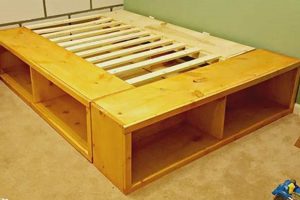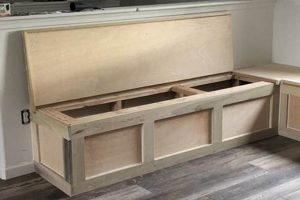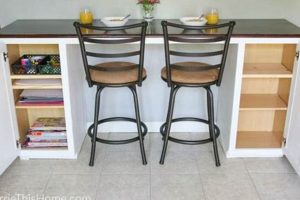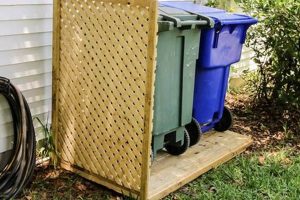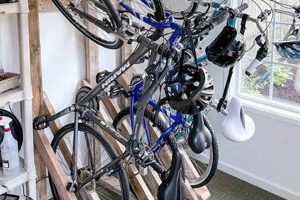The phrase refers to shelving units constructed at home using containers to provide organized storage. These structures typically involve repurposing or purchasing bins, then integrating them into a framework of shelves designed and assembled by the individual. One might, for instance, build a wooden frame and insert plastic bins as drawers or open storage compartments.
Such constructions offer several advantages, including cost-effectiveness through the utilization of readily available or recycled materials. They enable a high degree of customization, allowing dimensions and materials to be tailored to specific spatial requirements and aesthetic preferences. Historically, resourceful individuals have consistently sought affordable and adaptable storage solutions, leading to the frequent adoption of this approach.
The following sections will address the materials commonly used in building these solutions, outline several construction methods, and discuss potential applications within various home environments.
Construction Considerations
The successful creation of such storage solutions requires careful planning and execution. Attention to detail at each stage ensures structural integrity and longevity.
Tip 1: Material Selection: Evaluate the intended load capacity. High-density polyethylene (HDPE) bins and solid wood supports are appropriate for heavier items. Lighter gauge plastic and composite wood may suffice for lighter contents.
Tip 2: Structural Integrity: Ensure the support frame is adequately braced. Consider using corner brackets and cross-members to prevent racking and potential collapse. Screws are generally preferred over nails for greater holding power.
Tip 3: Bin Dimensions: Accurate measurements are crucial. Precise bin dimensions must be incorporated into the shelf design to avoid gaps or excessively tight fits. Leave a small allowance for ease of access.
Tip 4: Bin Securing Methods: Explore options for securing the bins to the frame. This may involve installing ledges, using metal clips, or employing friction-fit designs. Prevent accidental dislodging.
Tip 5: Weight Distribution: Distribute weight evenly across the shelves. Placing heavier items at the bottom promotes stability and reduces stress on the upper supports.
Tip 6: Safety Considerations: Sand down any sharp edges or splinters to prevent injury. If mounting the unit to a wall, use appropriate hardware and ensure it is anchored to a stud.
Tip 7: Consider Ventilation: When storing items that may be sensitive to moisture, ensure there is adequate air circulation within the bins to prevent mold or mildew growth.
Adhering to these suggestions will result in storage solutions that are both functional and durable, capable of withstanding regular use over an extended period.
The subsequent sections will address aesthetic considerations and offer strategies for integrating these storage units into various design schemes.
1. Bin Material
The selection of material for containers significantly dictates the utility and longevity of self-assembled storage units. The bin material influences load capacity, resistance to environmental factors, and overall aesthetic appeal. Inadequate material selection can lead to structural failure, rendering the entire storage system ineffectual. For example, employing thin, brittle plastic bins for storing heavy tools will likely result in cracking and eventual collapse of the storage structure.
Considerations when choosing bin material include the intended contents, the surrounding environment, and the desired lifespan of the shelving unit. High-density polyethylene (HDPE) is commonly chosen for its durability, resistance to moisture, and capacity to withstand significant weight. Alternatively, woven fabric bins offer breathability for clothing or linens but lack the rigidity required for heavier items. Metal bins provide exceptional strength and durability but are susceptible to rust in humid environments. Thus, matching the bin material to the application is essential for optimal performance.
In conclusion, the appropriate choice of material is crucial for maximizing the effectiveness of DIY storage bin shelving units. Understanding the physical properties of various materials, coupled with an awareness of the storage needs and environmental context, will ensure a functional and durable organizational solution. Overlooking the importance of bin material can negate the benefits of otherwise well-designed shelving.
2. Frame Strength
Frame strength is a foundational element of any self-constructed storage unit. It directly influences the unit’s ability to support the weight of the bins and their contents, maintain structural integrity over time, and provide a safe and reliable storage solution. Insufficient frame strength compromises the entire system, potentially leading to collapse and damage to stored items.
- Material Selection and Load Capacity
The choice of frame material is paramount. Wood, metal, and rigid plastics are common options, each possessing distinct load-bearing capabilities. For instance, a frame constructed from softwood lumber may be suitable for lighter loads such as clothing or books, while a steel frame is necessary for heavier items such as tools or canned goods. Accurate calculation of load capacity based on the chosen material is crucial to prevent overstressing the frame and causing failure.
- Joint Construction and Stability
The method of joining frame components significantly impacts overall strength. Screwed and glued joints offer greater stability than nailed joints. Reinforcement with metal brackets or gussets at critical junctions, such as corners, further enhances rigidity. Proper joint construction prevents racking or swaying of the frame, ensuring it remains stable under load. For example, a frame with poorly constructed joints may buckle or collapse when fully loaded with bins.
- Bracing and Support
Strategic bracing is essential for preventing lateral movement and distributing weight effectively. Diagonal bracing, either in the form of solid panels or cross-members, adds significant resistance to racking forces. Vertical supports positioned at regular intervals along the frame provide additional reinforcement and prevent sagging. The omission of adequate bracing can lead to instability, particularly in taller or wider units. Consider a bookshelf that wobbles excessively without any back panel.
- Frame Dimensions and Geometry
The overall dimensions and geometric configuration of the frame influence its load-bearing capacity. Taller and wider units require sturdier materials and more robust construction methods to maintain stability. The spacing between vertical supports must be optimized to prevent excessive bending or deflection of horizontal shelves. For example, a wide shelving unit with insufficient vertical supports may bow downwards under the weight of the bins.
In summary, frame strength is a critical consideration in the construction of self-assembled storage solutions. Careful material selection, proper joint construction, strategic bracing, and optimized frame geometry are all essential for ensuring a safe, durable, and functional storage unit. A weak or poorly constructed frame negates the benefits of an otherwise well-designed bin system, highlighting the importance of prioritizing structural integrity.
3. Space Optimization
The pursuit of space optimization forms a fundamental driver in the adoption of self-assembled storage solutions. The limited dimensions of many residences necessitate efficient use of available area. Failure to adequately optimize space can result in clutter, reduced functionality, and compromised aesthetic appeal. The careful design and implementation of these shelving units allows individuals to tailor storage to the specific contours and constraints of their environment.
A direct correlation exists between the degree of space optimization achieved and the functional value of the storage solution. For example, incorporating vertical shelving into a narrow hallway maximizes storage potential without significantly impeding passage. Building under-stair storage utilizes otherwise wasted volume. Custom-fitting shelves around existing architectural features, like pipes or irregular wall angles, eliminates dead space. The ability to precisely control dimensions and configurations allows for a highly efficient use of available area that is often unattainable with pre-fabricated storage units.
Achieving optimal space utilization presents inherent challenges, requiring careful planning and precise execution. Accurate measurement of available space, thorough assessment of storage needs, and a clear understanding of construction techniques are all prerequisites. Overlooking these factors can lead to poorly designed or incorrectly sized units that ultimately fail to maximize space. Despite these challenges, self-assembled storage offers a highly adaptable approach to space optimization in domestic environments.
4. Accessibility
Accessibility, in the context of self-constructed storage solutions, refers to the ease with which stored items can be retrieved or placed within the system. The design and implementation of shelving units must prioritize user convenience and minimize physical strain. A lack of accessibility diminishes the overall utility of the storage, rendering it inefficient and potentially frustrating to use.
- Shelf Height and Reach
The vertical positioning of shelves directly impacts accessibility. Shelves placed too high necessitate reaching, while those positioned too low require bending or stooping. The ideal height range varies depending on the user’s physical capabilities and the frequency of access. Items used most often should be stored within easy reach, minimizing strain and maximizing efficiency. The placement should be aligned to ergonomic principles that prioritize ease and safety.
- Bin Placement and Orientation
The orientation and placement of bins on the shelves significantly affect ease of access. Bins facing outwards with clear labeling facilitate quick identification and retrieval of contents. Bins placed too far back on the shelf may require reaching or maneuvering to access. The spacing between bins should allow ample room for hand insertion and removal. Thoughtful bin arrangement streamlines the storage process and reduces unnecessary effort.
- Bin Type and Opening Mechanisms
The design of the bins themselves influences accessibility. Bins with wide openings provide easier access compared to those with narrow openings. Features such as handles or integrated grips enhance maneuverability and reduce the risk of dropping items. Hinged lids or drawers offer convenient access while keeping contents concealed and protected. The selection of appropriate bin types contributes to a user-friendly storage system.
- Clearance and Obstructions
Adequate clearance around the shelving unit is essential for unimpeded access. Obstructions such as furniture or other stored items can hinder movement and make it difficult to reach the shelves. Sufficient aisle width allows users to approach the storage unit comfortably and retrieve items without difficulty. Maintaining a clear and unobstructed path promotes safety and efficiency.
In conclusion, accessibility constitutes a vital consideration in the design and construction of self-assembled storage solutions. Factors such as shelf height, bin placement, bin type, and clearance all contribute to the overall ease of use. Prioritizing accessibility enhances the functionality of the storage system and promotes a more organized and user-friendly environment. Overlooking these aspects can result in a cumbersome and inefficient storage solution, negating the benefits of customization.
5. Weight Capacity
Weight capacity is a critical consideration in the design and construction of self-assembled storage units. It dictates the unit’s ability to safely and effectively store items without risking structural failure. The following facets outline key elements related to weight capacity in the context of “diy storage bin shelves.”
- Material Selection and Load Limits
The materials used for both the frame and the bins significantly influence the maximum permissible weight. Wood, metal, and plastic possess varying load-bearing capabilities. For example, a shelving unit constructed from thin plywood will have a lower weight capacity than one made from solid hardwood or steel. Bins manufactured from low-density polyethylene are less capable of supporting heavy loads than those made from high-density polyethylene or metal. Exceeding the load limits of either the frame or the bins can result in deformation, cracking, or complete structural failure. It is crucial to ascertain the load limits of all component materials prior to construction.
- Structural Design and Distribution of Load
The design of the shelving unit and the method of load distribution impact its ability to withstand weight. A unit with multiple vertical supports and horizontal bracing will generally have a higher weight capacity than one with minimal support. Evenly distributing the weight across all shelves and within each bin prevents localized stress concentrations. Concentrating heavy items on a single shelf or in one area of a bin can overload that section, even if the overall weight remains within the stated limits. For example, placing all heavy tools in a single bin on a lightweight shelf could cause the shelf to bow or collapse. Load distribution is therefore as important as the total weight.
- Joint Strength and Fastener Capacity
The method used to join the components of the shelving unit directly affects its overall strength and weight capacity. Screwed and glued joints typically offer greater stability than nailed joints. Metal brackets and corner braces can reinforce joints and prevent racking. The type and size of fasteners used must be appropriate for the materials being joined and the anticipated load. Using undersized screws or nails can result in joint failure under stress. For example, a shelving unit with joints secured only by small nails may separate under moderate weight. The capacity of the fasteners must be considered in the overall weight assessment.
- Safety Factors and Tolerances
Prudent design incorporates a safety factor to account for unforeseen stresses, material imperfections, and variations in construction quality. This involves designing the unit to withstand a load greater than the expected maximum. A common safety factor is to design for a load 1.5 to 2 times greater than the anticipated maximum weight. This provides a margin of error and helps prevent failures due to unexpected stresses or manufacturing flaws. Ignoring safety factors can lead to catastrophic failures under seemingly normal loads. For example, designing a shelf to hold exactly the weight of the anticipated items without any margin for error increases the risk of collapse if the load is slightly greater than expected.
These facets underscore the critical role of weight capacity in the design and construction of self-assembled storage solutions. Failure to adequately consider these factors can lead to unsafe and unreliable storage systems. A thorough understanding of material properties, structural design principles, and safety factors is essential for creating functional and durable “diy storage bin shelves” capable of withstanding the intended loads.
6. Cost Effectiveness
The principle of cost-effectiveness constitutes a primary motivator for individuals undertaking self-assembled storage solutions. This approach inherently seeks to minimize expenses through the leveraging of readily available or recycled materials. The economic advantage stems from the reduced reliance on commercially manufactured shelving units, which often incur significant costs associated with production, distribution, and retail markups. Engaging in do-it-yourself construction allows for direct control over material selection and construction methods, thereby enabling significant cost savings. For instance, the utilization of reclaimed lumber and repurposed plastic containers, in lieu of purchasing new shelving, can substantially decrease project expenses.
The benefits extend beyond the initial material costs. Self-assembled solutions eliminate assembly fees associated with purchased furniture and reduce the potential for post-purchase modifications necessitated by spatial constraints. Customization allows for precise tailoring to specific storage needs, minimizing material waste and optimizing space utilization. Furthermore, the extended lifespan resulting from robust construction and readily available replacement parts contributes to long-term cost savings. The ability to adapt and modify the storage unit over time, as needs evolve, further enhances its economic value compared to static, pre-fabricated alternatives. Consider a growing family whose storage requirements shift; a modular, self-assembled solution can be readily expanded or reconfigured at minimal expense.
In conclusion, the pursuit of cost-effectiveness significantly drives the adoption of do-it-yourself storage bin shelving. By reducing reliance on commercial products, leveraging readily available materials, and enabling precise customization, individuals can realize substantial economic benefits. This approach not only minimizes initial expenses but also contributes to long-term savings through durability, adaptability, and reduced waste. While challenges exist in terms of time investment and skill requirements, the potential for cost savings makes this an attractive option for budget-conscious individuals seeking effective storage solutions.
Frequently Asked Questions
The following section addresses common inquiries regarding the planning, construction, and utilization of self-assembled storage units using bins.
Question 1: What types of materials are most suitable for constructing the frame of such shelving units?
Wood, metal, and rigid plastics are commonly employed. Wood offers ease of workability, while metal provides superior strength. The selection should align with the anticipated load and aesthetic preferences.
Question 2: How can one ensure the structural integrity of self-assembled storage?
Employing robust joint construction techniques, such as screwing and gluing, is crucial. Reinforcing corners with metal brackets and incorporating diagonal bracing further enhances stability.
Question 3: What factors should be considered when selecting bins for this type of storage system?
Material durability, load capacity, size, and accessibility are primary considerations. The chosen bin should withstand the weight of its contents and facilitate easy retrieval.
Question 4: Is it possible to build these storage units to accommodate specific spatial requirements?
Indeed. A significant advantage of self-assembly lies in the ability to customize dimensions to precisely fit available space, maximizing storage potential in constrained environments.
Question 5: What safety precautions should be observed during the construction and use of these shelving units?
Ensuring adequate bracing, distributing weight evenly, and anchoring the unit to a wall when necessary are essential safety measures. Addressing sharp edges or splinters prevents injury.
Question 6: How can the cost of building these storage solutions be minimized?
Utilizing recycled materials, such as reclaimed lumber or repurposed containers, is a cost-effective approach. Careful planning and accurate measurements reduce material waste.
In summary, careful planning, attention to structural integrity, and thoughtful material selection are paramount to creating functional and safe DIY storage bin shelves.
The subsequent section will provide design considerations for integrating these storage units into various interior styles.
Conclusion
The preceding sections have detailed the multifaceted nature of “diy storage bin shelves,” encompassing materials, construction methodologies, and application contexts. The importance of structural integrity, spatial optimization, and cost-effectiveness has been emphasized. From frame materials to joint construction, the aspects discussed guide the creation of storage solutions.
The potential benefits of adopting self-assembled bin shelving systems are numerous, and while challenges exist in terms of planning and execution, the rewards of customized, cost-effective, and space-efficient storage are considerable. Individuals should carefully assess their needs and available resources before embarking on such projects to maximize the efficacy of their efforts.


